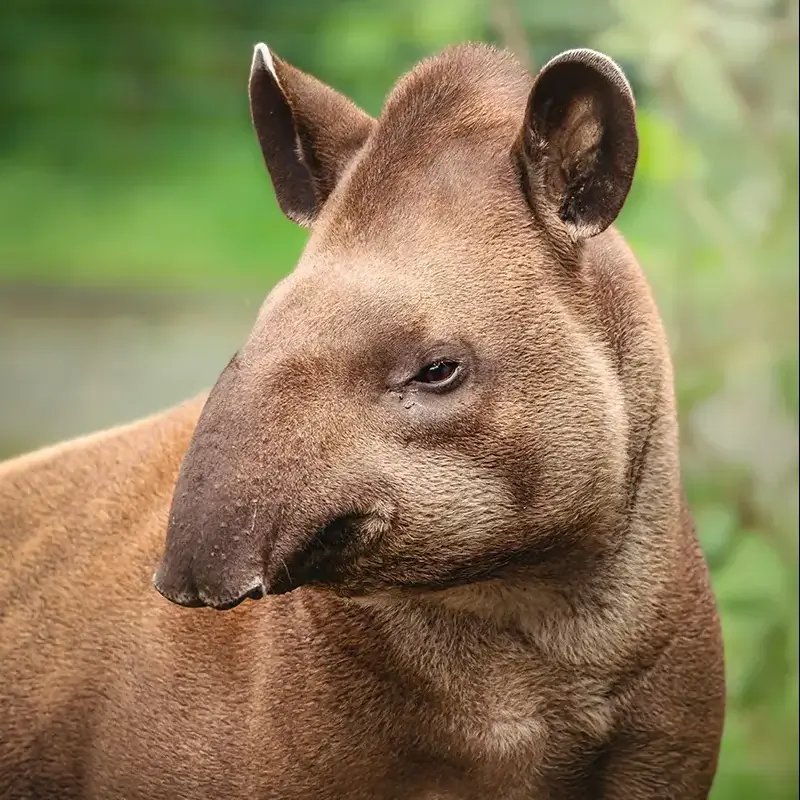
So, why should you care about tapirs? Well, these gentle, herbivorous giants have been around for millions of years and are often called “living fossils.” They are more than just a curious addition to our planet’s biodiversity; they also contribute to the health of their habitats. Let’s dive into some pretty amazing facts about tapirs that might just spark your interest!
1. There Are Four Species of Tapir
You might be surprised to learn that tapirs come in four different species! These include the Brazilian tapir, the Malayan tapir, the Mountain tapir, and the Baird’s tapir. Each species has unique traits and habitats:
- Brazilian Tapir: Found in the Amazon rainforest, they have a reddish-brown coat with lighter spots.
- Malayan Tapir: The most recognizable with its distinctive black and white markings, this species predominantly lives in Southeast Asia.
- Mountain Tapir: Living in the high-altitude forests of the Andes, they have a thicker coat to survive the cooler temperatures.
- Baird’s Tapir: This species roams Central America and is known for its long snout, which helps it reach leaves high in trees.
Each species has adapted to their environments in incredible ways. For example, the Malayan tapir’s camouflage helps it hide from predators, while the Mountain tapir’s fur keeps it warm in chilly climates.
2. Tapirs Are Excellent Swimmers
Here’s the thing: tapirs are surprisingly good swimmers! They have a unique ability to submerge themselves in water, using their long, flexible snouts like snorkels to breathe while swimming. This skill not only helps them evade predators but also allows them to forage for aquatic plants.
Their webbed feet also make them agile in the water. In fact, many tapirs are often found near rivers, swamps, and lakes. They enjoy cooling off in the water, especially in the heat of the tropical sun. Imagine lounging in a cool pool on a hot day; that’s basically a tapir’s vibe!
3. They Have Unique Physical Features
Tapirs have some truly distinctive features that set them apart from other animals. With their stocky bodies, short legs, and long snouts, they look quite different from your average mammal. Their snouts are what give them that elephant-like appearance, but it’s more about functionality than looks.
Their strong jaws help them munch on a variety of vegetation, including leaves, fruits, and grasses. You might be wondering how they manage to eat such tough stuff. Well, their teeth are specially adapted for grinding, making it easier for them to digest fibrous plants.
And let’s not forget about their skin! Covered in short, coarse hair, tapirs can sometimes appear a bit wrinkly. But this tough skin is crucial for protection against the rugged environments they inhabit.
4. Tapirs Are Nocturnal Creatures
Most tapirs are nocturnal, which means they are active during the night. You might be curious about why they chose to do this. Well, being nocturnal helps them avoid predators like jaguars and pumas, as well as the heat of the day.
At night, they roam the forests, foraging for food and socializing. They have a keen sense of smell, which is essential for locating food and communicating with other tapirs. Their social interactions include snorting or grunting sounds, which help them stay connected in the dark and dense forests.
Living a nocturnal lifestyle also allows tapirs to play a critical role in seed dispersal. As they munch on fruits, they pass the seeds throughout their environment, helping to maintain the health of their ecosystems.
5. They Are Surprisingly Social
Despite their solitary appearance, tapirs can be quite social animals. While they typically live alone, they have various ways of interacting with one another, especially during mating season. They communicate through vocalizations and scent marking, which helps establish their territory and attract mates.
You might even come across small family groups during the breeding season, where a female and her young might be seen together for a short time. Young tapirs remain with their mothers for about a year, learning essential survival skills along the way.
Their social side doesn’t just help them breed; it also fosters a sense of community within their species, promoting genetic diversity and healthier populations overall.
6. Tapirs’ Conservation Status
Unfortunately, tapirs are under threat. All four species are categorized as vulnerable or endangered, largely due to habitat loss, deforestation, and hunting. As humans continue to encroach on their habitats, tapirs are finding it increasingly challenging to thrive in their natural environments.
Conservation efforts are underway to protect these lovely creatures. Organizations are working tirelessly to preserve their habitats and raise awareness about their plight. It’s essential to understand that protecting tapirs also means protecting the entire ecosystem they sustain, as they play a vital role in maintaining plant diversity.
By supporting conservation efforts, we can help ensure that future generations have the chance to learn about and admire these incredible animals.
7. Their Unique Diet
Tapirs are herbivores, and their diet consists mainly of leaves, fruits, and other vegetation. You might think that eating plants sounds simple, but there’s a lot going on when it comes to their meals! They are known for their selective feeding habits, often opting for specific types of leaves or fruits based on what’s available in their environment.
Their strong jaws allow them to crush tough plant material effectively. Interestingly, tapirs’ diet plays a crucial role in their ecosystem. By consuming fruits and subsequently dispersing the seeds in their waste, they contribute to forest regeneration. It’s like they are nature’s gardeners, helping new plants grow as they wander through their habitats.
This unique feeding behavior is another reason why tapirs are such fascinating creatures. They aren’t just eating; they’re actively participating in the health of their environment.
8. Tapirs and Their Role in Mythology
In many cultures, tapirs hold significant symbolic meanings. In some South American mythology, they are viewed as creatures that connect the spirit world with the material one. Their unique features and gentle demeanor often lead to various stories and legends surrounding their existence.
For instance, in some indigenous beliefs, tapirs are seen as protectors of the forest and symbols of abundance. The relationship between these animals and local cultures emphasizes the interconnectedness of all living beings.
This cultural significance shows that tapirs are more than just animals; they represent the rich tapestry of life on Earth.
9. Tapirs Can Live a Long Time
If you’re curious about how long tapirs live, you might be surprised to learn they can live for 25-30 years in captivity! While their life expectancy in the wild is shorter—often around 20 years—those in protected environments can thrive much longer. They benefit from regular veterinary care, a stable food supply, and protection from predators.
Their longevity speaks to the importance of conservation efforts. By protecting tapirs in their natural habitats, we ensure they can live out their full potential and continue to play their role in the ecosystem.
10. How to Help Tapirs
Now that you know a bit about tapirs, you might wonder how you can help. Here are some simple yet impactful ways to contribute:
- Support Conservation Organizations: Donate to groups that focus on tapir conservation and habitat preservation.
- Spread Awareness: Talk to friends and family about tapirs and their importance in the ecosystem.
- Reduce Your Impact: Make eco-friendly choices to help minimize habitat destruction, like using sustainable products.
Every little bit helps when it comes to saving species at risk. By taking small actions in your daily life, you can contribute positively to the future of tapirs and the environments they inhabit.
In conclusion, tapirs are truly fascinating creatures that deserve our attention and protection. From their unique diets and excellent swimming skills to their cultural significance, there’s so much to appreciate about them. By learning about these wonderful animals, we can better understand the importance of wildlife conservation and our role in protecting the planet’s biodiversity.

